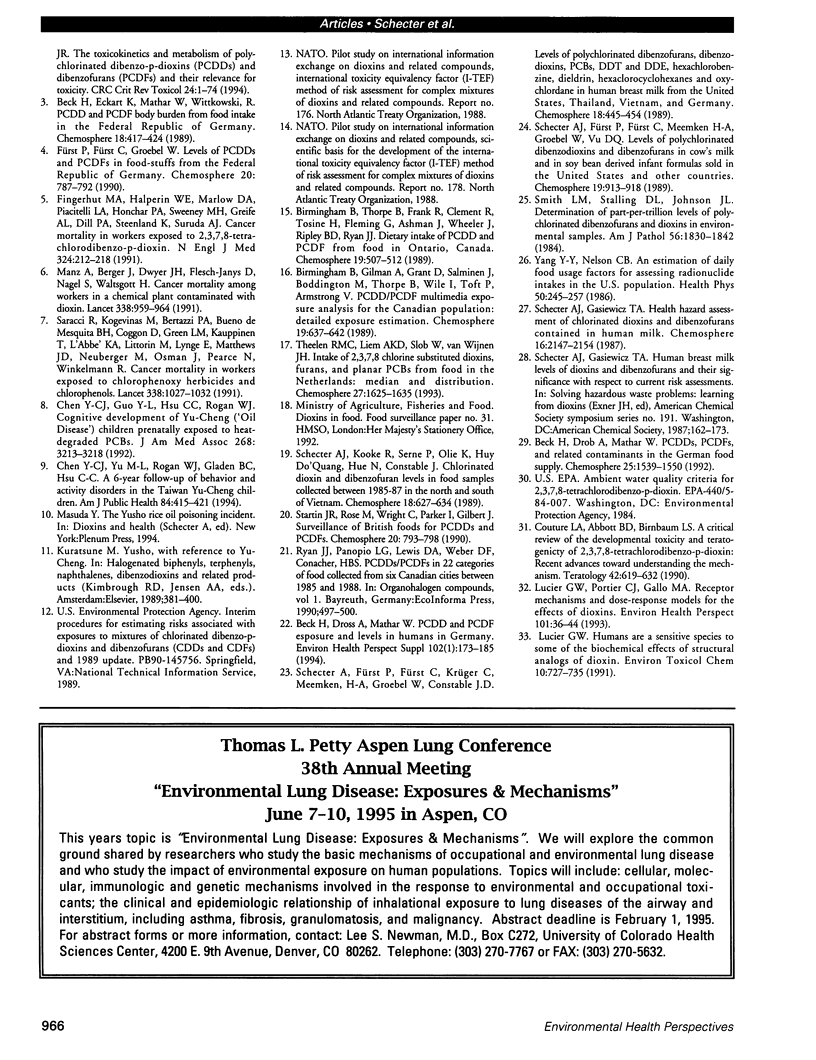Abstract
Food, especially meat, milk, and fish, is the immediate source of almost all polychlorinated dibenzo-p-dioxins (PCDDs), dibenzofurans (PCDFs), and dioxinlike compounds in the general population. To estimate intake of these highly toxic compounds, we performed congener-specific dioxin analyses for the first time on U.S. food for 18 dairy meat, and fish samples from a supermarket in upstate New York. 2,3,7,8 Tetrachlorodibenzo-p-dioxin (TCDD, "dioxin") toxic equivalents (TEqs) on a wet weight basis for the dairy products ranged for 0.04 to 0.7 ppt, meat TEqs ranged from 0.03 to 1.5 ppt, and fish TEqs ranged from 0.02 to 0.13 ppt. Previous human breast milk and infant formula analyses were used with the current preliminary food data to estimate a range of dioxin intake for Americans. Average daily food intake of TEqs for an adult weighing 65 kg was estimated to be between 0.3 and 3.0 pg/kg body weight, for a total of 18-192 pg TEq, using 1986 American consumption rates. Due to the relatively high level of PCDDs and PCDFs commonly found in human breast milk from American women and from women in other industrial countries, a nursing infant may consume an average of 35-53 pg TEq/kg body weight/day in its first year of life. This may be compared with the current U.S. EPA virtually safe dose of 0.006 pg TCDD/kg body weight per day over a 70-year lifetime based on an upper limit cancer risk of 10(-6), or the 10 pg/kg/day used by some European government agencies.
Full text
PDF




Selected References
These references are in PubMed. This may not be the complete list of references from this article.
- Beck H., Dross A., Mathar W. PCDD and PCDF exposure and levels in humans in Germany. Environ Health Perspect. 1994 Jan;102 (Suppl 1):173–185. doi: 10.1289/ehp.94102s1173. [DOI] [PMC free article] [PubMed] [Google Scholar]
- Chen Y. C., Guo Y. L., Hsu C. C., Rogan W. J. Cognitive development of Yu-Cheng ("oil disease") children prenatally exposed to heat-degraded PCBs. JAMA. 1992 Dec 9;268(22):3213–3218. [PubMed] [Google Scholar]
- Chen Y. C., Yu M. L., Rogan W. J., Gladen B. C., Hsu C. C. A 6-year follow-up of behavior and activity disorders in the Taiwan Yu-cheng children. Am J Public Health. 1994 Mar;84(3):415–421. doi: 10.2105/ajph.84.3.415. [DOI] [PMC free article] [PubMed] [Google Scholar]
- Couture L. A., Abbott B. D., Birnbaum L. S. A critical review of the developmental toxicity and teratogenicity of 2,3,7,8-tetrachlorodibenzo-p-dioxin: recent advances toward understanding the mechanism. Teratology. 1990 Dec;42(6):619–627. doi: 10.1002/tera.1420420606. [DOI] [PubMed] [Google Scholar]
- Fingerhut M. A., Halperin W. E., Marlow D. A., Piacitelli L. A., Honchar P. A., Sweeney M. H., Greife A. L., Dill P. A., Steenland K., Suruda A. J. Cancer mortality in workers exposed to 2,3,7,8-tetrachlorodibenzo-p-dioxin. N Engl J Med. 1991 Jan 24;324(4):212–218. doi: 10.1056/NEJM199101243240402. [DOI] [PubMed] [Google Scholar]
- Lucier G. W., Portier C. J., Gallo M. A. Receptor mechanisms and dose-response models for the effects of dioxins. Environ Health Perspect. 1993 Apr 22;101(1):36–44. doi: 10.1289/ehp.9310136. [DOI] [PMC free article] [PubMed] [Google Scholar]
- Manz A., Berger J., Dwyer J. H., Flesch-Janys D., Nagel S., Waltsgott H. Cancer mortality among workers in chemical plant contaminated with dioxin. Lancet. 1991 Oct 19;338(8773):959–964. doi: 10.1016/0140-6736(91)91835-i. [DOI] [PubMed] [Google Scholar]
- Saracci R., Kogevinas M., Bertazzi P. A., Bueno de Mesquita B. H., Coggon D., Green L. M., Kauppinen T., L'Abbé K. A., Littorin M., Lynge E. Cancer mortality in workers exposed to chlorophenoxy herbicides and chlorophenols. Lancet. 1991 Oct 26;338(8774):1027–1032. doi: 10.1016/0140-6736(91)91898-5. [DOI] [PubMed] [Google Scholar]
- Smith L. M., Stalling D. L., Johnson J. L. Determination of part-per-trillion levels of polychlorinated dibenzofurans and dioxins in environmental samples. Anal Chem. 1984 Sep;56(11):1830–1842. doi: 10.1021/ac00275a018. [DOI] [PubMed] [Google Scholar]
- Yang Y. Y., Nelson C. B. An estimation of daily food usage factors for assessing radionuclide intakes in the U.S. population. Health Phys. 1986 Feb;50(2):245–257. doi: 10.1097/00004032-198602000-00008. [DOI] [PubMed] [Google Scholar]


